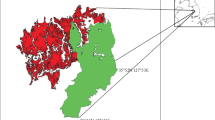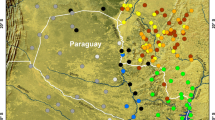Abstract
In this paper we consider one method of mapping larger units identified from the spatial pattern of sequences of vegetation types. The basic data were presence/absence data for 6450 stands arranged in 90 transects. A second set of data was derived by averaging the species occurrences in non-overlapping groups of 5 stands. A divisive numerical classification was used to determine the primary vegetation units. In all, 5 different sets of primary types were derived, using different species suites, different sample sizes and different numerical methods. We briefly discuss the types identified and their spatial patterns in the area.
Each of these types was then used to define a string of ‘type-codes’ for every transect so that each transect represents a sample from the landscape containing information on the frequency and spatial distribution of the primary vegetation types. The transects may be classified using a Levenshtein dissimilarity measure and agglomerative hierarchical classification, giving 5 analyses of transects, one for each of the primary types discussed above. We then examine these transect classifications to investigate the stability of the vegetation landspace patterns under changes in species used for the primary classification, in size of sample unit and in method of primary classifications. There is a considerable degree of stability in the results. However it seems with this vegetation that the tree species and non-tree species have considerable independence. We also indicate some problems with this approach and some possible extensions.
Similar content being viewed by others
Refernces
Belbin, L. 1987. The use of nonhierarchic allocation methods. Aust. Comput. J. 19: 32–41.
Bouxin, G. & LeBoulengé, E. 1983. A phytosociological system based on multi-scaled pattern analysis: a first example. Vegetatio 54: 3–16.
Coutts, R. & Dale, P. E. R. 1988. Patterns of vegetation, in: Catterall, C. P. & Wallace, C. J. (eds), An island in Suburbia: a natural and social survey of Toohey Forest. Chap. 3.5. Inst. Appl. Environ. Res., Griffith University, Nathan, Qld.
Dahl, E., Prestvik, O. & Toftaker, H. 1981. En kvantifiserung av karakterartbegrepet. Kgl. Norsk Vidensk. Selsk. Mus. Bot. Ser. 5: 215–233.
Dale, M. B. In press a. Ideals and instances-some fuzzy approaches to phytosociology. Folia Geobot. Phytotax.
Dale, M. B. In press b. Similarity measures for structured data. Vegetatio.
Dale, M. B. In press c. Mutational and nonmutational similarity measures: a preliminary examination. Paper presented to the First Conf., Int. Fed. Classif. Socs., Aachen. Coenoses.
Dale, M. B. & Anderson, D. J. 1973. Qualitative and quantitative information analysis. J. Ecol. 60: 639–657.
Dale, M. B., Clifford, H. T. & Ross, D. R. 1984. Species, equivalence and morphological redescription: a Stradbroke Island vegetation study, in: Coleman, R. J., Covacevich, J. & Davie, P. (eds), Focus on Stradbroke: new information on North Stradbroke Island and surrounding areas, 1974–1984. Boolarong Publ., Brisbane & Stradbroke Island Management Organization, Amity Point.
Faith, D. P., Minchin, P. R. & Belbin, L. 1987. Compositional dissimilarity as a robust measure of ecological distance. Vegetatio 69: 57–68.
Fewster, P. H. & Orlóci, L. 1982. On choosing a resemblance measure for non-linear predictive ordination. Vegetatio 54: 27–35.
Hill, M. O., Bunce, R. G. H. & Shaw, M. W. 1975. Indicator species analysis, a divisive polythetic method of classification and its application to a survey of native pine-woods in Scotland. J. Ecol. 63: 597–613.
Jensén, S. & van derMaarel, E. 1974. Numerical approaches to lake classification with special reference to macrophyte communities. Vegetatio 42: 117–128.
Juhász-Nagy, P. & Podani, J. 1983. Information theory methods for the study of spatial processes and succession. Vegetatio 51: 129–140.
Kaufman, L. & Rousseeuw, P. J. 1985. Clustering large data sets, in: Gelsema, E. S. & Kanal, L. N. (eds), Pattern recognition in practice II. pp. 425–437. Amsterdam.
Lance, G. N. & Williams, W. T. 1966. A generalised sorting strategy for computer classifications. Nature 212: 218.
Lance, G. N. & Williams, W. T. 1968. Note on a new information statistic classification program. Comput. J. 11: 195.
Lance, G. N. & Williams, W. T. 1975. POLYDIV: a divisive classificatory program for all-numeric data. Aust. Comp. J. 7: 144.
Little, I. P. & Ross, D. R. 1985. The Levenshtein metric, a new means for soil classification tested by data from a sand-podzol chronosequence and evaluated by discriminant analysis. Aust. J. Soil Res. 23: 115–130.
Mäkirinta, U. 1978. Die Pflanzensoziologische Gliederung der Wasservegetation im See Kukkia, Süd Finnland. Acta Univ. Oul. Ser A, Sci. Rer. Nat. 75, Biol. 5, 158 pp.
Mojena, R. 1977. Hierarchical grouping methods and stopping rules: an evaluation. Comput. J. 20: 359–363.
Moore, R. K. 1979. A dynamic programming algorithm for the distance between two finite areas. IEEE Trans. Patt. Anal. Machine Intell. PAMI- 1: 86–88.
Narasimha Murty, M. & Krishna, G. 1979. A computationally efficient technique for data clustering. Pattern Recogn. 12: 153–158.
Podani, J. 1984. Spatial processes in the analysis of vegetation: theory and review. Acta Bot. Hung. 30: 75–118.
Ross, D., Dale, M. B., Shields, K. & Hulett, C. 1983. TAXON Users Manual Edition P4. CSIRO Division Computing Res., Canberra. Ref. Man. 6.
Sneath, P. H. A. 1985. DENBRAN: a BASIC program for a significance test for multivariate normality of clusters from branching points in dendrograms. Comput. Geosci. 11: 767–785.
Webb, L. J., Tracey, J. G., Williams, W. T. & Lance, G. N. 1967. Studies in the numerical analysis of complex rain-forest communities II. The problem of species sampling. J. Ecol. 55: 525–538.
Weir, A. D. (update K. Mayo) 1972. Program DIVINFRE: a divisive classification on binary data, including re-allocation. CSIRO Div. Land Research, Tech. Memo. 72/4. pps 10. Canberra.
Westman, W. E. 1978. Evidence for the distinct evolutionary history of canopy and understorey in the Eucalyptus forest-heath alliance of Australia. J. Biogeog. 5: 365–376.
Williams, W. T., Lance, G. N., Webb, L. J., Tracey, J. G. & Connell, J. H. 1969. Studies in the numerical analysis of complex rain-forest comunities IV. A method for the elucidation of small-scale forest pattern. J. Ecol. 57: 635–654.
Author information
Authors and Affiliations
Rights and permissions
About this article
Cite this article
Dale, M.B., Dale, P.E.R. & Coutts, R. Classification of vegetation sequences in Toohey Forest, Queensland. Vegetatio 76, 113–129 (1988). https://doi.org/10.1007/BF00045473
Accepted:
Issue Date:
DOI: https://doi.org/10.1007/BF00045473




